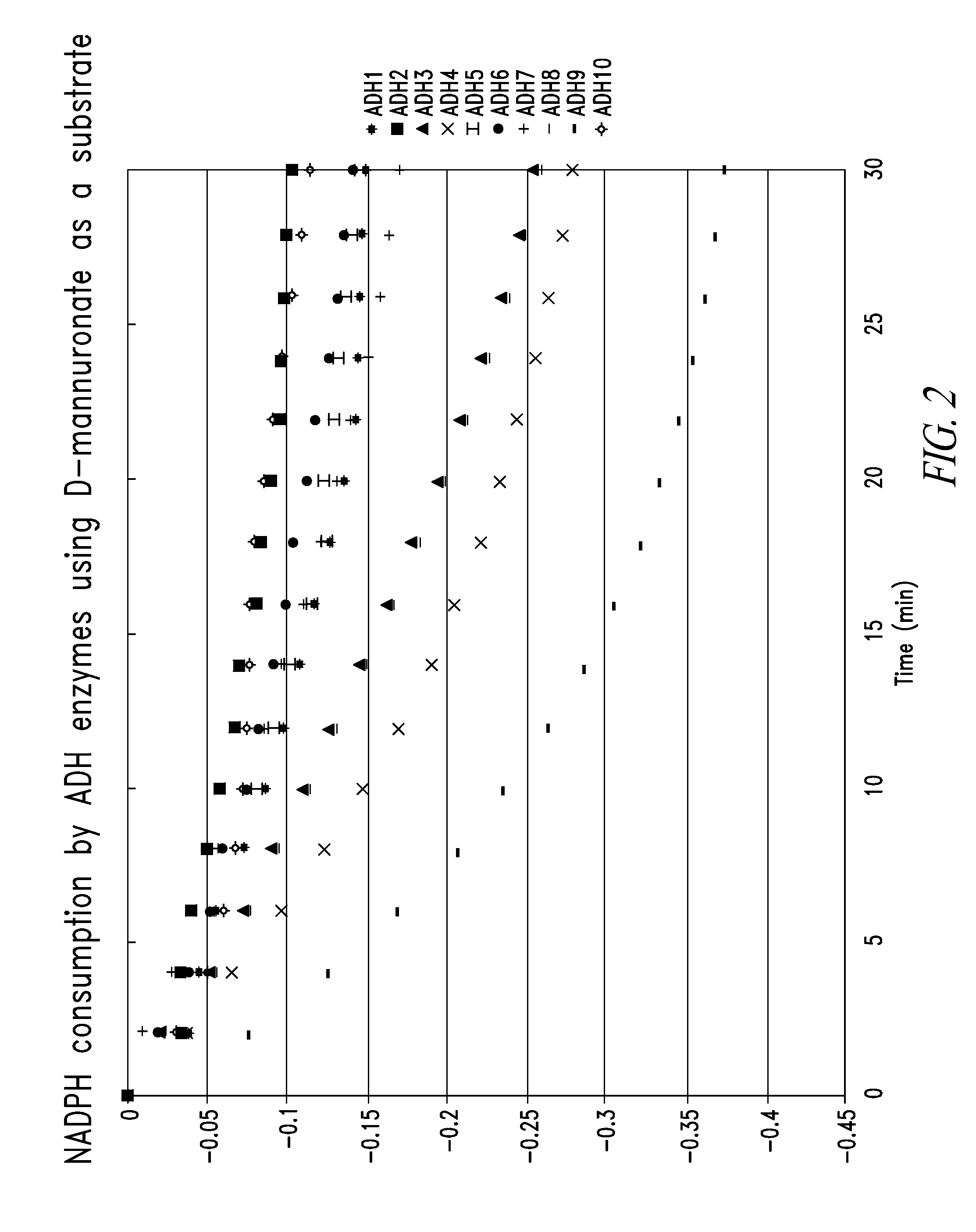Isolated alcohol dehydrogenase enzymes and uses thereof
- Summary
- Abstract
- Description
- Claims
- Application Information
AI Technical Summary
Benefits of technology
Problems solved by technology
Method used
Image
Examples
example 1
Cloning of Alcohol Dehydrogenases
[0209]All chemicals and enzymes were purchased from Sigma-Aldrich, Co. and New England Biolabs, Inc., respectively, unless otherwise stated. Since mannitol 1-dehydrogenase (MTDH) catalyzes a similar reaction to DEHU hydrogenase, primers were designed using the amino acid sequences MTDHs derived from Apium graveolens and Arabidopsis thaliana. Using these primers as queries (see Table 1), homogeneous gene sequences were searched in the genome sequence of Agrobacterium tumefaciens C58. Approximately 16 genes encoding zinc-dependent alcohol dehydrogenases were found. Among these genes, top 10 gene sequences with high E-value were amplified by PCR: 98° C. for 10 sec, 55° C. for 15 sec, and 72° C. for 60 sec, repeated for 30 times. The reaction mixture contained 1× Phusion buffer, 2 mM dNTP, 0.5 μM forward and reverse primers (listed in the table 1), 2.5 U Phusion DNA polymerase (Finezyme), and an aliquot of Agrobacterium tumefaciens C58 cells as a templat...
example 2
Characterization Of Alcohol Dehydrogenases
[0211]Preparation of oligoalginate lyase Atu3025 derived from Agrobacterium tumefaciens C58. pETAtu3025 was constructed based on pET29 plasmid backbone (Novagen). The oligoalginate lyase Atu3025 was amplified by PCR: 98° C. for 10 sec, 55° C. for 15 sec, and 72° C. for 60 sec, repeated for 30 times. The reaction mixture contained 1× Phusion buffer, 2 mM dNTP, 0.5 μM forward (5′-GGAATTCCATATGCGTCCCTCTGCCCCGGCC-3′) (SEQ ID NO:45) and reverse (5′-CGGGATCCTTAGAACTGCTTGGGAAGGGAG-3′) (SEQ ID NO:46) primers, 2.5 U Phusion DNA polymerase (Finezyme), and an aliquot of Agrobacterium tumefaciens C58 (gift from Professor Eugene Nester, University of Washington) cells as a template in total volume of 100 μl. The amplified fragment was digested with NdeI and BamHI and ligated into pET29 pre-digested with the same enzymes using T4 DNA ligase to form pETAtu3025. The constructed plasmid was sequenced (Elim Biophamaceuticals) and the DNA sequence of the inser...
example 3
Engineering E. Coli to Grow on Alginate as a Sole Source of Carbon
[0218]Wild type E. coli cannot use alginate polymer or degraded alginate as its sole carbon source (see FIG. 4). Vibrio splendidus, however, is known to be able to metabolize alginate to support growth. To generate recombinant E. coli that use degraded alginate as its sole carbon source, a Vibrio splendidus fosmid library was constructed and cloned into E. coli. (see, e.g., related U.S. application Ser. No. 12 / 245,537, which is incorporated by reference in its entirety).
[0219]To prepare the Vibrio splendidus fosmid library, genomic DNA was isolated from Vibrio Splendidus B01 (gift from Dr. Martin Polz, MIT) using the DNeasy Blood and Tissue Kit (Qiagen, Valencia, Calif.). A fosmid library was then constructed using Copy Control Fosmid Library Production Kit (Epicentre, Madison, Wis.). This library consisted of random genomic fragments of approximately 40 kb inserted into the vector pCC1FOS (Epicentre, Madison, Wis.).
[...
PUM
| Property | Measurement | Unit |
|---|---|---|
| Fraction | aaaaa | aaaaa |
| Fraction | aaaaa | aaaaa |
| Fraction | aaaaa | aaaaa |
Abstract
Description
Claims
Application Information
 Login to View More
Login to View More - R&D
- Intellectual Property
- Life Sciences
- Materials
- Tech Scout
- Unparalleled Data Quality
- Higher Quality Content
- 60% Fewer Hallucinations
Browse by: Latest US Patents, China's latest patents, Technical Efficacy Thesaurus, Application Domain, Technology Topic, Popular Technical Reports.
© 2025 PatSnap. All rights reserved.Legal|Privacy policy|Modern Slavery Act Transparency Statement|Sitemap|About US| Contact US: help@patsnap.com



